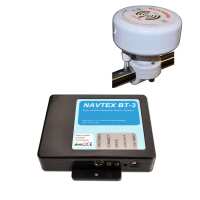
The new bluetooth Navtex is a dual frequency Navtex receiver that decodes and stores Navtex messages for viewing on an Android bluetooth enabled mobile phone or tablet. The unit is designed to be run continuously and have the stored messages downloaded as and when required by the user. An android app enables the user to search the stored messages or to program the device to display only wanted message types from selected stations. The internal memory stores in excess of four hundred typical Navtex messages with new messages overwriting the oldest. The receiver is supplied with a an H-vector antenna. The H-vector antenna has a standard 14 tpi mount and is connected to the receiver using the seven metre cable provided. It can be either surface of rail mounted and there are several suitable, optional mounts available. A fused power cable is also supplied to connect the receiver to a permanent 12 volt power source. The android app can be freely downloaded from the google play store. For Apple users there is an optional IOS app, go to the app store and search for ‘navtex’ 518 and 490kHz message reception 12 volt supply with low 27mA current consumption Connects to H Vector or standard Series 2 antenna Supply voltage 10 to 16 volts DC Dimensions 135 x 100 x 30mm Antenna length 195mm (complete with 7 metre cable) Supplied with H Vector active antenna, fused power cable Compatible with smart phones and tablets *H-Vector antenna railmount in image not included. Available as an optional extra.
Visit Product Page
